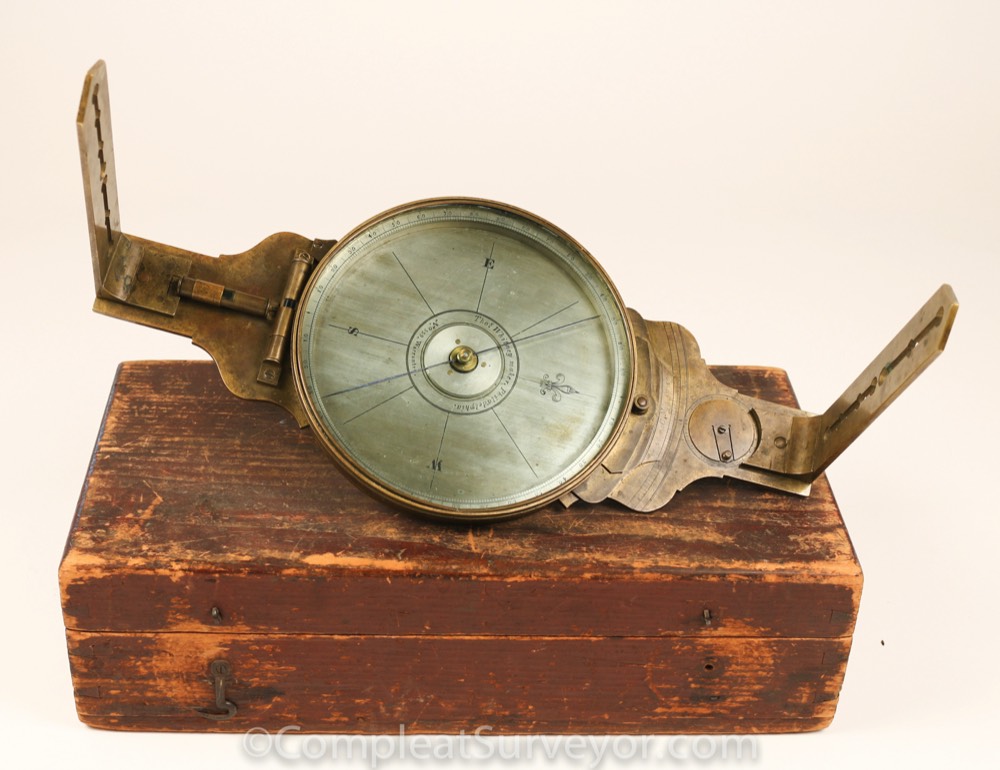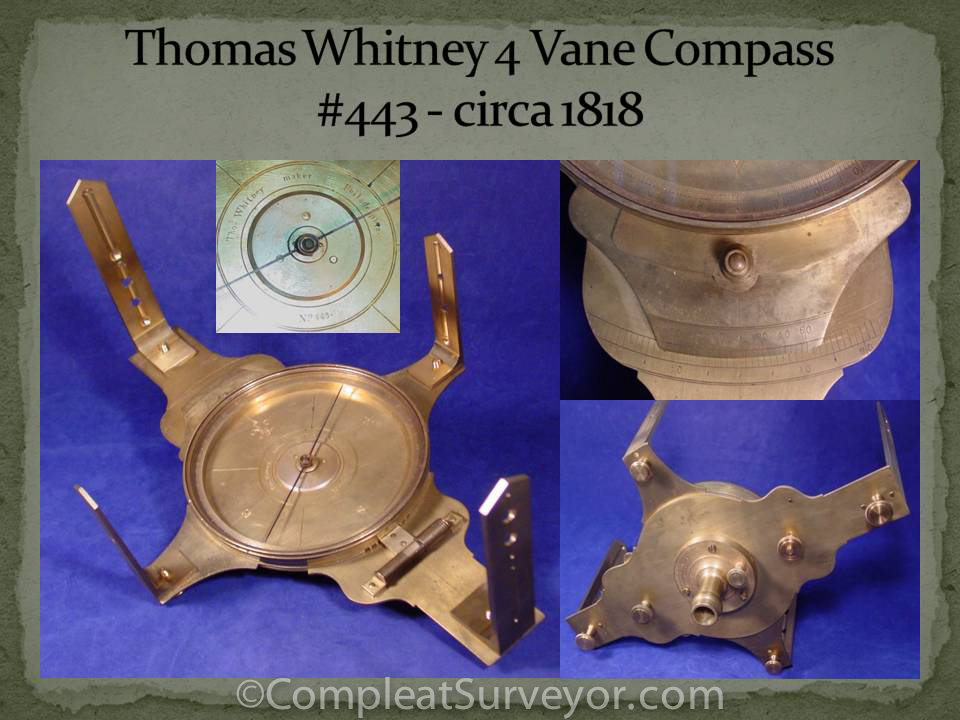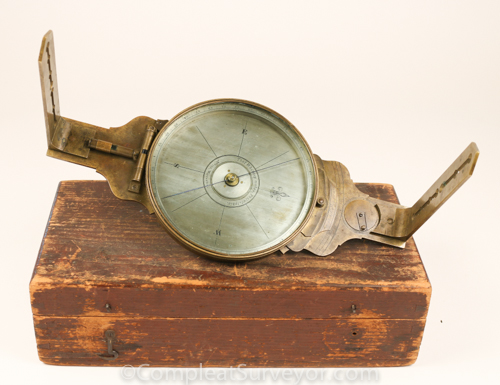
Thomas Whitney
History
Thomas Whitney
1765-1823
Thomas Whitney was born before 1765, perhaps in or near London, England, and died on July 30, 1823 at his residence near Philadelphia according to Paulson’s American Daily Advertiser dated August 7, 1823. He served an apprenticeship in London with Samuel Browning in the Grocers' Company beginning on Sept. 5, 1782, he was free of the Company as of Jan. 7, 1790. He then went to Philadelphia, Pa. before 1798, he is known to have owned a dividing engine made by the London maker George Adams.
He set up shop in Philadelphia and, according to an announcement in the Federal Gazette for April 12, 1798, prepared to make "various instruments in the most approved and accurate manner.” He moved from 72 (late Mr. Gould's) to No. 74 South Front Street. and continued a little above the Mill Pond 70 South Front Street, all in Philadelphia, Pa where he makes various instruments in the most approved manner. Thomas Whitney listed in Pennsylvania directories from 1802 to 1824 as a mathematical maker and supplier of instruments. In the 1802 directory he is listed as “Whitney, Thos., mathematical instrument maker, 95, S. Second.” Thomas Whitney advertised in Paxton’s Philadelphia Annual Advertiser in 1819, and again in 1820 where he states he had produced about 500 surveying compasses during the preceding thirteen years and is located on North Sixth Street, near the Mill Pond 1 mile from Philadelphia.
Whitney is known to have supplied many of the instruments used by the Lewis and Clark expedition. Over the course of the next quarter century, Whitney made surveyor’s compasses, and a few other instruments as well "the good qualities of which are well known to many Surveyors, in at least sixteen of the States and Territories of the Union." Whitney sold plain compasses for thirty to thirty-seven dollars, and "Nonius or Minute" compasses for forty to sixty dollars. He also kept a "book of record for Magnetic Observations” and invited contributions from "any gentleman who is pleased to throw light on this important subject. Whitney did not depend solely on the sale of instruments for his income. Bunting by the piece was sold, writing slates and razors, silversmith's anvils and files; pen-knives and sailor's pocket knives, scissors and bone moulds - whatever they may be - could all be purchased at the shop of Thomas Whitney from London.
Whitney also trained William J. Young, who would become the most important mathematical instrument maker in the United States in the middle decades of the 19th century. William James In the files of Wm. J. Young is a copy of the indenture of William James Young to Thomas Whitney of the township of N. Liberties, County of Philadelphia dated the 13 day of January 1813. Young at the age of 15 or 16 was indentured as an apprentice to Thomas Whitney from 1813 to 1820. It is believed that William Helffircht also apprenticed with Thomas Whitney in the late 1820’s, there is a privately owned Whitney compass serial No. 505 with William Helffrichts name under the socket dating to this timeframe.
John Whitney, possibly his son, succeeded Thomas at the shop at 70 South Front Street in Philadelphia.
The Gurley company has repaired a compass marked, "Thos. Whitney, Phila 1828.
Original Compass at the Smithsonian
Among the collections at the Smithsonian Institution’s National Museum of American History is the actual original compass used by Lewis and Clark on their great expedition. Meriwether Lewis and William Clark and the Corps of Discovery set out from St. Louis to survey the Northwest portion of the Louisiana Purchase. Sometime after completion of the expedition, Clark gave the pocket compass to Captain Robert McCabe, an army man with whom he had dealings in the 1820’s. It passed down through the McCabe family and eventually to the Smithsonian Institution. This brass and silver compass, set in a mahogany box was made by Thomas Whitney of Philadelphia and was used by William Clark. It is one of the few surviving scientific instruments from the expedition organized by President Thomas Jefferson in 1803 to explore the Missouri River and search for possible routes across the continent to the Pacific Ocean. On 13 Jun 1802, Thomas Jefferson wrote to Thomas Whitney asking questions concerning optical astronomical instruments.
With the assistance of Patterson and Whelen, Lewis was able to obtain most of the instruments he required, the majority coming from Thomas Whitney's shop on Water Street. In addition to making and selling instruments, Whitney also modified them as required by his clients. For example, he attached a small high-powered reading lens, which he called a "microscope," to the index arm of the sextant that Lewis purchased. A user needed magnification to read the sextant's vernier scale, and at this time sextants were equipped with separate hand-held magnifiers that fitted into the field case. It was not until a decade or more later that a lens attached directly to the index arm of the sextant became a standard feature.
Whitney provided a total of fifteen instruments to the expedition, at a cost of $162.20. All were practical selections. From him Lewis purchased a late model octant with tangent screw, probably English, for $22. It had a fourteen-inch radius and a vernier scale, and was capable of back observations. For $90, he also obtained a sextant with a ten-inch radius and a vernier scale, equipped with three eyepieces a hollow tube and two telescopes, one of which reversed the image. A cased set of plotting, or drafting, instruments was used for map making; the spirit level and two-pole chain were standard surveying equipment. The log line, reel, and log-ship were used with a timekeeper to determine the speed of a ship or boat, or the distance it had run in a given period of time. A brass boat or marine compass was a basic necessity for navigating. Lewis purchased one silver plated pocket compass, probably for his own use, and three others of brass. Since a compass was an item that was frequently damaged or lost, he made certain that he would have replacements. From Whitney he also obtained a spare parallel glass and a slab of talc as replacements for the artificial horizon prepared for the expedition by Ellicott.
THOMAS WHITNEY advertised in the Federal Gazette of April 12, 1798, as from London, and "moved from 72 (late Mr. Gould's) to No. 74 South Front Street where he makes various instruments in the most approved and accurate manner." Whitney did not depend solely on the sale of instruments for his income. Bunting by the piece was sold, writing slates and razors, silversmith's anvils and files; pen-knives and sailor's pocket knives, scissors and bone moulds—whatever they may be—could all be purchased at the shop of Thomas Whitney from London. We read in the city directory of 1801 that John Whitney occupied No. 74 South Front Street and his occupation is given as a Mathematical Instrument Maker and Optician. John evidently was a son and succeeded his father. The makers of mathematical and scientific instruments of metal were not our only instrument craftsmen. Scientific and philosophical implements of glass were also needed and these were likewise made in our early city. The wine and spirit merchants as well as those who recorded weather conditions desired apparatus of glass for their various purposes. These too were supplied.
Dating Whitney Instruments
Dating Information Developed By Robert C. Miller
Compleat Surveyor Instruments
Additional Pictures

© 2020 Russ Uzes/Contact Me



